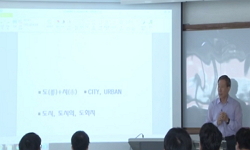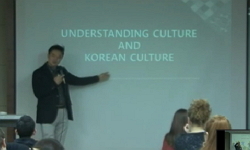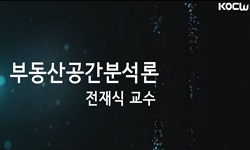This study examines the meaning of sport stadium and urban regeneration centering on stakeholders’ recognition surrounding the construction of the Gocheok Sky Dome. The Gocheok Sky Dome, opened in 2015, is the first large professional domed sport st...
http://chineseinput.net/에서 pinyin(병음)방식으로 중국어를 변환할 수 있습니다.
변환된 중국어를 복사하여 사용하시면 됩니다.
- 中文 을 입력하시려면 zhongwen을 입력하시고 space를누르시면됩니다.
- 北京 을 입력하시려면 beijing을 입력하시고 space를 누르시면 됩니다.

스포츠 스타디움과 도시재생: 고척스카이돔을 중심으로 = Sport Stadium and Urban Regeneration: The Case of Gocheok Sky Dome
한글로보기https://www.riss.kr/link?id=A106279438
- 저자
- 발행기관
- 학술지명
- 권호사항
-
발행연도
2019
-
작성언어
Korean
- 주제어
-
등재정보
KCI등재
-
자료형태
학술저널
- 발행기관 URL
-
수록면
56-75(20쪽)
-
KCI 피인용횟수
0
- DOI식별코드
- 제공처
-
0
상세조회 -
0
다운로드
부가정보
다국어 초록 (Multilingual Abstract)
This study examines the meaning of sport stadium and urban regeneration centering on stakeholders’ recognition surrounding the construction of the Gocheok Sky Dome. The Gocheok Sky Dome, opened in 2015, is the first large professional domed sport stadium in South Korea located in Gocheok-dong, Guro-gu, which can be said to be quite meaningful to South Korean society. The Gocheok-dong area, located on the outskirts of Seoul, is an area where Yeongdeungpo Prison was located in the past and is known for a small population, frequent traffic congestion, and uncomfortable public transportation networks. Therefore, exploring the sport stadium constructed in Gocheok-dong and the meaning of urban regeneration can be a valuable work. Concretely, this study was aimed to explore the meaning of construction of sport stadiums and urban regeneration in Korean society through a qualitative research method. A total of nine participants in this study were selected from the category of persons related to the Korea Baseball Association, persons related to the local government, and representatives of the community, who are major stakeholders related to the construction of the Gocheok Sky Dome, and the study was conducted through in-depth interviews. The perception of major skateholders were mostly positive, primarily in terms of economic revitalization. The results of this study were shown to be as follows. First, a new cultural space called stadium was born. Diverse cultural performance events that can be held regardless of the weather thanks to the nature of the dome stadium led to increases in population inflows to Gocheok-dong and the expansion of the surrounding commercial area thereby forming the area around the Gocheok Sky Dome into a venue of cultural spaces. Second, the city image was changed. The image of a city of 'prison' has been changed into the image of a city of 'Dome Stadium', which became a momentum of spread of a positive perception of Gocheok-dong. Third, the city and the lives of local residents were changed. Gocheok Sky Dome inspired attachment to the city and pride to local residents and secured convenience and safety to provide new spaces for communication and exchanges. Fourth, the view of baseball development and the meaning of Gocheok Sky Dome could be identified from the viewpoint of urban regeneration. As the first dome stadium, Gocheok Sky Dome was promoting the development of Gocheok-dong area along with expansion of baseball base through the attraction of diverse competitions.
국문 초록 (Abstract)
본 연구는 스포츠 스타디움과 도시재생의 의미를 고척스카이돔의 건립을 둘러싼 이해관계자들의 인식을 중심으로 살 펴보는 것이다. 2015년 개장한 고척스카이돔은 구로구 고척동에 위치한 ...
본 연구는 스포츠 스타디움과 도시재생의 의미를 고척스카이돔의 건립을 둘러싼 이해관계자들의 인식을 중심으로 살 펴보는 것이다. 2015년 개장한 고척스카이돔은 구로구 고척동에 위치한 대한민국 최초의 프로스포츠 대형 돔구장으 로써 한국 사회에 의미하는 바가 크다. 서울시의 외곽에 위치한 고척동 일대는 과거 영등포교도소가 있던 지역으로 적은 유동인구와 잦은 교통체증, 불편한 대중교통망으로 알려져 있었다. 따라서 고척동에 건립된 스포츠 스타디움과 도시재생의 의미를 탐색하는 것은 가치 있는 작업이 될 수 있다. 구체적으로 본 연구에서는 질적 연구방법을 통해 한 국 사회 내 스포츠 스타디움의 건립과 도시재생의 의미를 알아보고자 하였다. 연구참여자는 고척스카이돔 건립과 관 련한 주요 이해관계자인 야구협회 관계자, 지자체 관계자, 지역사회 대표자의 범주에서 총 9명을 선정하였고, 심층면 담을 통해 연구를 진행하였다. 주요 이해관계자들의 인식은 대부분 긍정적이었으며, 주로 경제 활성화의 측면에서 고 척돔을 바라보고 있었다. 본 연구의 결과는 다음과 같이 나타났다. 첫째, 스타디움이라는 새로운 문화공간의 탄생이 다. 돔구장의 특성상 날씨와 관계없이 개최 가능한 다양한 문화공연행사는 고척동으로의 인구 유입 증가와 주변 상권 의 확대로 이어지며 고척돔 일대를 문화공간의 장으로 형성되었다고 인식하였다. 둘째, 도시 이미지의 변화이다. 과 거 ‘교도소’의 도시 이미지는 ‘돔구장’의 도시 이미지로 변화하였으며, 이를 통해 고척동에 대한 긍정적인 인식이 확 대되는 계기가 된 것으로 여겨졌다. 셋째, 도시의 변화와 지역주민 삶의 변화이다. 고척돔은 지역주민들에게 도시 애 착심, 자부심을 고취시켰으며, 편의성과 안전성을 확보하여 새로운 소통과 교류의 공간을 제공한 것으로 이해하였다. 넷째, 야구의 발전과 도시재생 관점에서 고척돔의 의미를 확인할 수 있었다. 고척돔은 국내 최초의 돔구장으로 다양 한 대회유치를 통한 야구의 저변확대와 더불어 고척동 일대의 발전을 촉진시킨 것으로 나타났다.
참고문헌 (Reference)
1 한승백, "한국 프로야구의 야구장 짓기: 미디어 속 공공재 담론의 변주와 합주" 한국스포츠사회학회 30 (30): 45-69, 2017
2 장승현, "피트니스클럽 공간의 생산: 일상적 공간으로서 실천, 재현, 전유" 한국스포츠사회학회 27 (27): 51-78, 2014
3 최민규, "특집 : 달콤 쌉싸름했던 2015 한국스포츠 ;"고척돔"스포츠문화의 새장을 열다" 133 : 2-9, 2015
4 정상원, "지역 체육 · 스포츠시설 이용자의 서비스 기대 및 성과 탐색" 한국사회체육학회 (47) : 397-412, 2012
5 미디어스, "야구장, 고척돔 먹자골목 상권 활성화 박차"
6 이투데이, "야구만 즐기나? 고척스카이돔, 新 여가공간으로 자리매김"
7 이혁기, "스포츠, 공간, 사회: 스포츠공간에 관한 공간사회학적 고찰" 한국체육학회 52 (52): 117-128, 2013
8 이유찬, "스포츠 시설 이용시 도시 커뮤니티 형성에 미치는 영향" 39 (39): 154-167, 2000
9 이병수, "스포츠 마당 : 동대문운동장은 반드시 보존돼야 할 근대문화유산" 101 : 100-107, 2007
10 박성배, "스포츠 경기장의 현재와 미래" 인물과 사상 158-170, 2016
1 한승백, "한국 프로야구의 야구장 짓기: 미디어 속 공공재 담론의 변주와 합주" 한국스포츠사회학회 30 (30): 45-69, 2017
2 장승현, "피트니스클럽 공간의 생산: 일상적 공간으로서 실천, 재현, 전유" 한국스포츠사회학회 27 (27): 51-78, 2014
3 최민규, "특집 : 달콤 쌉싸름했던 2015 한국스포츠 ;"고척돔"스포츠문화의 새장을 열다" 133 : 2-9, 2015
4 정상원, "지역 체육 · 스포츠시설 이용자의 서비스 기대 및 성과 탐색" 한국사회체육학회 (47) : 397-412, 2012
5 미디어스, "야구장, 고척돔 먹자골목 상권 활성화 박차"
6 이투데이, "야구만 즐기나? 고척스카이돔, 新 여가공간으로 자리매김"
7 이혁기, "스포츠, 공간, 사회: 스포츠공간에 관한 공간사회학적 고찰" 한국체육학회 52 (52): 117-128, 2013
8 이유찬, "스포츠 시설 이용시 도시 커뮤니티 형성에 미치는 영향" 39 (39): 154-167, 2000
9 이병수, "스포츠 마당 : 동대문운동장은 반드시 보존돼야 할 근대문화유산" 101 : 100-107, 2007
10 박성배, "스포츠 경기장의 현재와 미래" 인물과 사상 158-170, 2016
11 서울경제, "면세점·야구장 등에 업고... 여의도 63시티 일대·구로 고척 구일역 인근 상권 후끈"
12 박재우, "돔구장, 약인가? 독인가?:미디어에 나타난 돔구장 건설 관련 사회적 담론 분석" 한국콘텐츠학회 12 (12): 378-393, 2012
13 서원석, "대규모 프로스포츠시설 입지에 따른 도시특성요인 비교분석" 한국콘텐츠학회 16 (16): 712-721, 2016
14 김종수, "기술기사 : 대형돔구장 건립의 필요성" 11 (11): 30-33, 2011
15 조명래, "공간으로 사회 읽기 : 개념, 쟁점과 대안" 한울아카데미 2013
16 매일경제, "고척동의 변신...서울 서남부 新주거타운으로"
17 국민일보, "고척돔만 ‘플레이볼’...프로야구 수도권 3경기 우천취소"
18 뉴시스, "고척돔, 도쿄돔보다 좋네...일본 야구장 관리자들 견학"
19 이두정, "[프로젝트 리포트] 서남권 돔야구장" 57 (57): 87-95, 2013
20 Pelissero, J. P., "Urban regimes, sports stadiums, and the politics of economic development agendas in Chicago" 10 (10): 117-129, 1991
21 Zukin, S., "Urban lifestyles: diversity and standardisation in spaces of consumption" 35 (35): 825-839, 1998
22 Jeffrey, P., "Urban Regeneration: A Handbook" Sage Publications 86-108, 2000
23 Roberts, P., "Urban Regeneration: A Handbook" Sage Publications 9-36, 2000
24 Hritz, N., "The perceived impacts of sport tourism : An urban host community perspective" 24 (24): 119-138, 2010
25 Buckman, S., "The impact of urban form on downtown stadium redevelopment projects : A comparative analysis of Phoenix and Denver" 5 (5): 1-22, 2012
26 Coates, D., "The growth effects of sport franchises, stadia, and arenas" 18 (18): 601-624, 1999
27 Alexander, D. L., "The economic determinants of professional sports franchise values" 5 (5): 51-66, 2004
28 Kozma, G., "The changing role of sports in urban development : A case study of Debrecen" 31 (31): 1118-1132, 2014
29 Harvey, D., "The Condition of Postmodernity" Blackwell 1989
30 Gunter, A., "Stadium upgrades as local economic development : The fallacy of the Ellis Park sports precinct upgrade as LED" 93 (93): 75-88, 2011
31 Ahlfeldt, G., "Stadium architecture and urban development from the perspective of urban economics" 34 (34): 629-646, 2010
32 Lipsitz, G., "Sports stadia and urban development : A tale of three cities" 8 (8): 1-18, 1984
33 Barghchi, M., "Sports facilities development and urban generation" 5 (5): 460-465, 2009
34 Chapin, T. S., "Sports facilities as urban redevelopment catalysts : Baltimore's Camden Yards and Cleveland's Gateway" 70 (70): 193-209, 2004
35 Koch, N., "Sports and the city" 12 (12): 2018
36 Sam, M. P., "Sport in the city : cultural political connections" 13 (13): 1417-1422, 2010
37 Yuen, B., "Sport and urban development in Singapore" 25 (25): 29-36, 2008
38 Davies, L. E., "Sport and economic regeneration : A winning combination?" 13 (13): 1438-1457, 2010
39 Rosentraub, M. S., "Sport and downtown development strategy: If you build it, will jobs come?" 16 (16): 221-239, 1994
40 Hassan, D., "Sport and Communities" Routledge 2014
41 Smith, A., "Sport In The City" Routledge 127-148, 2001
42 Kennelly, J., "Seeing Olympic effects through the eyes of marginally housed youth : Changing places and the gentrification of East London" 27 (27): 151-160, 2012
43 Cheng, E., "Residents' perception of the social-cultural impacts of the 2008 Formula 1 Singtel Singapore Grand Prix" 14 (14): 91-106, 2010
44 Creswell, J. W., "Qualitative Inquiry and Research Design" Sage 2007
45 Campbell Jr, H. S., "Professional sports and urban development : A brief review of issues and studies" 29 (29): 272-292, 1999
46 Lorde, T., "Local residents’ perceptions of the impacts of the ICC Cricket World Cup 2007 on Barbados : Comparisons of pre-and post-games" 32 (32): 349-356, 2011
47 Bassa, Z., "Living close to 2010 stadiums: Residents’ perceptions of the 2010 FIFA World Cup and stadium development in Durban, South Africa" 17 (17): 121-145, 2010
48 Spirou, C., "Cultural policy and the dynamics of stadium development" 13 (13): 1423-1437, 2010
49 Lee, J. W., "Critical Geographies of Sport: Space, Power and Sport in Global Perspective" Routledge 142-156, 2017
50 Baade, R. A., "An analysis of the economic rationale for public subsidization of sports stadiums" 22 (22): 37-47, 1988
51 Silk, M. L., "A tale of two cities : The social production of sterile sporting space" 28 (28): 349-378, 2004
52 Jones, C., "A level playing field? Sports stadium infrastructure and urban development in the United Kingdom" 33 (33): 845-861, 2001
동일학술지(권/호) 다른 논문
-
- 한국스포츠사회학회
- 김대희
- 2019
- KCI등재
-
남성 축구선수들이 경험한 합숙훈련의 소외, 기능 그리고 사슬
- 한국스포츠사회학회
- 명왕성
- 2019
- KCI등재
-
토픽모델링을 적용한 한국스포츠사회학회지의 연구주제 분석
- 한국스포츠사회학회
- 장익영
- 2019
- KCI등재
-
노인의 운동실천이 연령규범에 미치는 영향- 삶의 만족도 매개효과 분석
- 한국스포츠사회학회
- 김수연
- 2019
- KCI등재
분석정보
인용정보 인용지수 설명보기
학술지 이력
| 연월일 | 이력구분 | 이력상세 | 등재구분 |
|---|---|---|---|
| 2026 | 평가예정 | 재인증평가 신청대상 (재인증) | |
| 2020-01-01 | 평가 | 등재학술지 유지 (재인증) |  |
| 2017-01-01 | 평가 | 등재학술지 유지 (계속평가) |  |
| 2013-01-01 | 평가 | 등재학술지 유지 (등재유지) |  |
| 2010-01-01 | 평가 | 등재학술지 유지 (등재유지) |  |
| 2008-01-01 | 평가 | 등재학술지 유지 (등재유지) |  |
| 2007-05-03 | 학술지명변경 | 한글명 : 한국스포츠사회학회 -> 한국스포츠사회학회지 |  |
| 2006-01-01 | 평가 | 등재학술지 유지 (등재유지) |  |
| 2003-01-01 | 평가 | 등재학술지 선정 (등재후보2차) |  |
| 1999-07-01 | 평가 | 등재후보학술지 선정 (신규평가) |  |
학술지 인용정보
| 기준연도 | WOS-KCI 통합IF(2년) | KCIF(2년) | KCIF(3년) |
|---|---|---|---|
| 2016 | 1.2 | 1.2 | 1.18 |
| KCIF(4년) | KCIF(5년) | 중심성지수(3년) | 즉시성지수 |
| 1.28 | 1.39 | 1.147 | 0.22 |




 DBpia
DBpia





